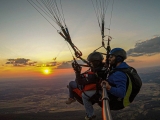
Although it's not an extreme sport in most cases, the terrain is often uneven and being in a natural environment means we're at the mercy of weather conditions or any unforeseen circumstances.
To ensure a pleasant experience, you must consider having essential basic equipment when hiking or trekking: But first, don't miss this quick guide to mountain first aid. All information is welcome - better safe than sorry!
ESSENTIAL EQUIPMENT FOR HIKING
Clothing
Avoid wearing very tight clothing as constant friction while walking may cause wounds, especially when your skin is sweaty. Neither is very loose clothing advisable, as depending on the trail conditions you might suffer snags, trips, etc. Steer clear of short sleeves or vest tops or you'll likely end up with scratches and sun irritation (at best).
- Trousers: Choose the right size and make sure they're waterproof. Multiple pockets are a bonus, allowing quick access to small tools or navigation equipment (compasses, GPS, mobile, etc.)
- T-shirts: Long-sleeved and breathable: they'll prevent excessive sweating and help keep you cool.
- Boots/footwear: Probably the most crucial part of your outfit and where hiking beginners most commonly make mistakes. Remember you'll be walking on natural, unpaved terrain which will be uneven. Ensure your boots support your ankles to prevent sprains. They should have wide soles to protect your feet's soles and ideally be waterproof. If heat makes this undesirable, use specific hiking sandals, commonly known as approach shoes.

- Socks: Most importantly, they should absorb sweat to prevent blisters, be soft and your correct size so they don't slip or bunch up. The fabric will depend on the season.
- Waterproof jacket or clothing: Beware of passing storms. They're hard to predict and might catch you mid-trail. This clothing is lightweight and won't take up much backpack space.
The Backpack
This article also includes 10 essentials for your mountain backpack.
Your trekking backpack must absolutely contain water. Hydration is essential, especially in hot weather. Also bring some energy food. It doesn't have to be artificial like energy bars or gels - fruit provides hydration plus natural glucose.

Pack sunscreen and sunglasses, even when you think there's no risk. Unless it's a night hike, you'll spend hours in the sun. Reapply sunscreen every two hours maximum, or after getting wet. You want a pleasant experience, not increased melanoma risk. For the same reason, include headwear: caps, hats, bandanas will prevent headaches... literally.

You'll also need a torch with batteries. If you haven't planned well (essential) or are night hiking, you'll need illumination. Also a small first aid kit with anti-diarrhoea medication, wound care items (disinfectant, gauze, adhesive tape, plasters, etc.), antipyretics, painkillers, antihistamines, energy gels and water purification tablets. The whole group doesn't need to carry this - one person is enough, but ensure it's complete.
Trekking Poles
Consider taking one or two trekking poles. They help distribute weight on ascents/descents and prevent injuries. They improve balance, let your arms assist your legs (which do most work), reduce leg fatigue and even build upper body muscle (all advantages!).

They come in various types, but opt for lightweight (aluminium or carbon), telescopic poles with breathable grips, secure locks and tungsten tips. Be careful using them in snow.
Communication Equipment
Today this seems obvious, but take a mobile. It needn't be the latest model though a smartphone with internet is recommended. Not for checking Facebook and WhatsApp constantly (though some might disagree).

It's for emergencies: getting lost, injuries preventing continuation, etc. when you need to call for help or rescue. Plus, with good signal, Google Maps or compass apps work perfectly. Some have pedometers, or you can add wearable accessories.
With this essential hiking equipment, you'll be ready to enjoy your experience safely!
If you're keen to start hiking and meet people, don't miss our Adventurer Community, particularly our hiking centres. Spain's best network - guaranteed!











